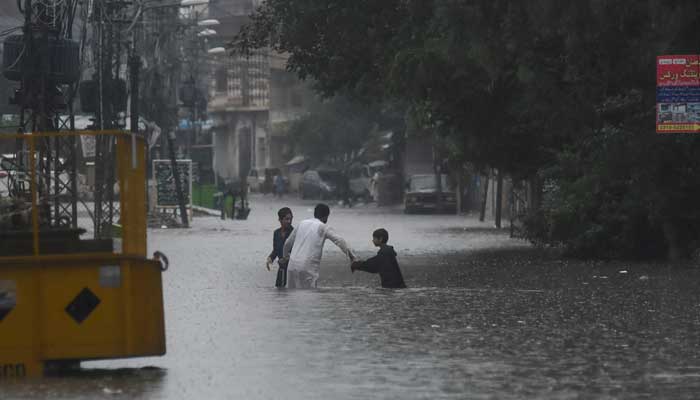ISLAMABAD: The death toll from ongoing monsoon spell has jumped to 221 as five more people were killed in related-incidents in the last 24 hours, the National Disaster Management Authority (NDMA) said.
The disaster response agency said cloudbursts battered parts of the country, unleashing flash floods, landslides and lightning strikes, particularly in mountainous regions.
The latest casualties include two men and three children, while ten others were injured in rain-related incidents during the same period.
So far, 592 people have suffered injuries in heavy downpour-led accidents this monsoon season. Among them were 77 men, 40 women, and 104 children. Punjab remains the worst-hit province, with 135 deaths and 470 injuries recorded.
In Khyber Pakhtunkhwa, 40 people have lost their lives and 69 have been hurt. Sindh has reported 22 casualties and 40 wounded. Balochistan has confirmed 16 fatalities, while Azad Kashmir saw one death and six people harmed. Gilgit Baltistan reported three non-fatal casualties, while Islamabad saw one fatality.
Most of the deaths have been caused by structural collapses, drowning, landslides, flash floods, lightning strikes, and electrocution.
The NDMA report further stated that 25 houses collapsed in the last 24 hours, while five cattle were also killed. Since the start of the monsoon season, 804 houses have been damaged or destroyed, and 200 heads of livestock have been lost.
In terms of property damage, Punjab reported 168 partially damaged homes. KP saw 142 homes partially damaged and 78 tumbled. Sindh reported 54 partially and 33 fully collapsed homes.
In Balochistan, 56 homes were partially damaged and 8 were flattened.
In GB, 71 homes were partially damaged while 66 were completely razed by rain. Azad Kashmir reported 75 partially broken homes and 17 completely destroyed. Islamabad recorded 35 partial collapses and one full.
The authority also warned of a flood emergency in Babusar, where torrential rains triggered flash floods and landslides in a 7-8 km radius around Babusar Top. At least 14 to 15 routes have been blocked, and stranded tourists have been safely moved to Chilas.
Moreover, rescue and relief efforts are ongoing, but with more rainfall forecast in the coming days, disaster management authorities have strongly advised citizens to take precautions, especially those in flood-prone or low-lying areas.
Monsoon rains are a routine part of South Asia’s climate and are essential for crop irrigation and replenishing water supplies.
However, their adverse impact has worsened in recent years due to rapid urban expansion, poor drainage systems, and more frequent extreme weather events linked to climate change.
More rains expected across country
The Pakistan Meteorological Department (PMD) has issued a detailed weather forecast for Tuesday, warning of widespread rain, wind, and thundershowers in multiple regions, including AJK, KP, Islamabad, Punjab, and GB.
While parts of the country will continue to experience hot and humid weather, several areas are likely to receive heavy to very heavy rainfall during the forecast period.
The PMD has cautioned on July 22 intense rainfall may lead to flash flooding in local nullahs and streams. This risk is particularly high in northern and hilly regions such as Chitral, Dir, Swat, Shangla, Mansehra, Kohistan, Abbottabad, Buner, Charsadda, Nowshera, Swabi, Mardan, Murree, Galliyat, Islamabad, Rawalpindi, as well as in the hill torrents of Dera Ghazi Khan, northeastern Punjab, and AJK.
Heavy downpours could also trigger urban flooding in low-lying areas of major cities including Islamabad, Rawalpindi, Gujranwala, Lahore, Sialkot, Sargodha, Faisalabad, Okara, Nowshera, and Peshawar.
Additionally, the risk of landslides and mudslides looms large over vulnerable hilly regions of Khyber Pakhtunkhwa, Murree, Galliyat, AJK and GB.

